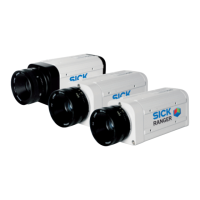Chapter 5 Reference Manual
Ranger E/D
54 ©SICK AG • Advanced Industrial Sensors • www.sick.com • All rights reserved
Configuring Ranger E and D
Consider the binary images in the figure again. In the first example, the noise peak re-
mains, and the profile result is not improved, but in the second example the result is
improved.
5.9 Color Data Acquisition
The ColorRanger camera acquires color data by separately measuring the red, green and
blue light reflected by the object. The color measurement results in three streams of color
data, or color channels. Before the color channels can be combined into a high quality
color image, they need to adjusted in terms of:
White balancing
Color channel registration
White balancing and color channel registration can be done independent of each other
and in any order. Typically, the white balancing is done when configuring the camera (so
that the camera delivers white balanced color data), and the registration is done while
measuring, in the PC using the iCon API.
In addition, the geometry, alignment and illumination are important when acquiring color
data. See chapter 3 “Mounting Rangers and Lightings” for more guidelines on mounting
the ColorRanger.
5.9.1 White Balancing
Good white balancing is necessary to ensure proper color measurements. In a properly
white balanced measurement, white and grey objects give equal values in all three color
channels, and objects appear with natural colors.
White balancing is necessary since different light sources have different spectral proper-
ties, combined with the fact that the sensor itself is not equally sensitive to all colors.
Figure 5.17 –Left: Poorly white balanced. The image has a violet tint, and the values for
red, green and blue channels differ.
Right: Properly white balanced. The image is neutral grey and values for red,
green and blue channels are almost equal.
In the color component (used for color measurements) you specify the exposure time for
the red channel in microseconds. The other channels’ exposure times are specified as a
percentage of the red channel’s exposure time. This way the overall brightness can be
adjusted by changing only one exposure time parameter and without affecting the white
balance.
Note that the exposure time for the channels cannot be longer than the cycle time. If this
should happen, the camera sends a warning message indicating that the acquired data is
not white balanced.
White balancing using Ranger Studio is described in section 4.4.6 “White Balancing the
Color Data”.
Some light sources allow for adjustments of its spectral content. In that case it is possible
to white balance by tuning the light source.

